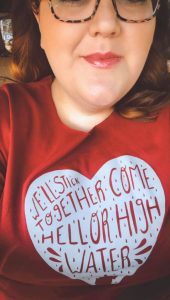By Lyra Bordelon
Although it might feel like an entire year has passed since June, there are some in Alderson who are still feeling the immediate effects of the storm that tore through the town on June 22. If anything, explained Greater Greenbrier Long Term Recovery Committee (GGLTRC) Director Kayla McCoy, the risk will rise for a couple of families, and will only continue to increase as the year goes on.
“I want to stress than we have an immediate need, seriously in the next two months, … for about $38,000,” explained McCoy. “That way we can build someone a bridge and make sure a family has a safe way in and out of a warm home, and make sure that people have structural damage [to their home] repaired.”
The storm damaged over 90 homes across both the Greenbrier and Monroe county-sides of Alderson. Although hundreds of thousands of dollars worth of damage has been documented, the event did not rise to the needed $2.8 million threshold for qualifying for federal aid. Between this and the COVID-19 cancellation of many typical fundraisers, a big gap has been left in funding for those affected. Of these, two homes in particular are a priority for the GGLTRC.
“It’s going to be a long, cold, difficult winter for some people [if we don’t raise the funds],” McCoy explained. “…The flood wiped out their insulation, their heat pump, destroyed the egress to their home. It caused some structural damage to their foundation. Not only are they in a difficult situation, but a very unsafe one as well.”
However, this doesn’t mean funding has completely dried up – in addition to grant applications, over 100 people became first-time donors to local disaster relief.
“We have seen more individual donations since June 19 than we have seen since 2016,” McCoy said. “From June 19 to July 15, we had 102 individual donations with more than 90 of them being first time donors. That doesn’t include everything since then.”

Photo courtesy of Kayla McCoy.
The final tally updated to Friday, September 25, brought the number over 150, accounting for new donations and t-shirt sales. T-shirts are currently still available for those that would like one, featuring a heart, rain, West Virginia, and the phrase “We’ll stick together come hell or high water.” In order to make a donation or get a t-shirt, go to the GGLTRC website, http://ggltrc.org/, or email volunteer@ggltrc.org.
“They can contact me, email is good, [or you can] go online, make a $25 donation. In the memo line, put your size and address,” McCoy said. “… The need is still so great that even though we’ve seen -”
McCoy stopped for a moment and turned, the ringing of new incoming messages that had served as an arrhythmic soundtrack to the interview now growing so constant she had to stop speaking to laugh.
“At this point I kind of want to leave it, I don’t want to silence it,” McCoy said.
The ringing served as a metaphorical reminder for the people still left to help. Since the June flooding event, more than 90 homes have been identified as having been damaged in some way. Although not every one of the these properties need the same level of help, McCoy pointed to 16 that need assistance, and two that are of the highest priority.
“The need is still so great, it’s still an uphill battle at this point,” McCoy said. “We are very hopeful that the grant applications that we have out will be fruitful. Right now, I’m waiting for $19,000 from four or five different sources. That’s a good chunk. It’s slow, it’s steadier than I anticipated, and for that I am grateful, but I still need to convey they we have some cases that are in some dire situations, and we need to get them situated. We really need to close those cases and have them in safe, secure environments before any sort of bad weather, winter weather, hits. … That doesn’t include ones that we’re still trying to work with through partnering agencies to determine if they [fit] their missions, their scope of work, because that overall need is still a very large number. It’s still in the neighborhood of $400,000.”
McCoy asked that if someone is only able to give a small amount and feels discouraged because of that, they should set that aside and donate just a small amount.
“My dad, God rest his soul, used to say ‘no one can do everything, but everyone can do something,'” McCoy said. “I think a lot of times people are hesitant, I’m guilty of this myself, to do any kind of charitable giving because they feel like their five dollar donation isn’t going to be impactful, whereas if I had 1,000 people who said ‘I’d really love to help but all I can give is five dollars,’ that’s $5,000. That’s a third of a bridge, that’s an HVAC system repaired for family. Everyone can do something. … Don’t think what little contribution you can make won’t be impactful. I’ll make sure it’s impactful.”
For more on the Greater Greenbrier flood recovery efforts, check out the Mountain Messenger’s previous coverage:
• Several $25K Bridges are a partial solution to a nearly $1 million flash flooding problem
• Youth group helps clean up Alderson home with 2016 and 2020 flooding damage
• GGLTRC seeks donations to fill major funding void in wake of 85 damaged Alderson properties
• Alderson flash flood damage not eligible for federal funds
• Alderson flash flood brings damages throughout town, no injuries reported



